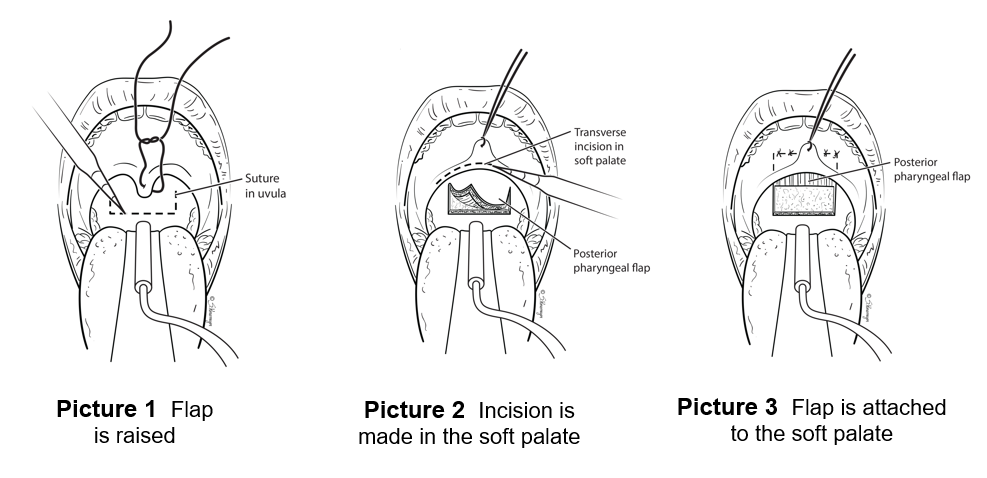Posterior Pharyngeal Flap (PPF) Surgery

Posterior Pharyngeal Flap (PPF) is a surgery done to help correct velopharyngeal dysfunction, or VPD.
VPD occurs when the soft palate cannot properly separate the back of the mouth from the nose during speech. Children and adults with VPD often have nasal-sounding speech, with abnormal air leaking through the nose as they talk. (See Helping Hand HH-I-448, Velopharyngeal Dysfunction for more information).
Diagnosis
VPD may be caused by a relatively short soft palate, poor palate function, or both. Risk factors for VPD include cleft palate, submucous cleft palate, 22q11.2 deletion syndrome or other genetic conditions. In some cases, VPD may occur after adenoid removal.
If VPD is suspected, your child’s surgeon and speech-language specialist may do special tests to confirm that VPD is present. (See Helping Hand HH-I-444 Nasopharyngoscopic Evaluation of Velopharyngeal Closure during Speech or HH-III-148 Multiview Speech Fluoroscopy.)
Once a decision is made to proceed with surgery to correct VPD, your child may have more testing done, such as an MRI, sleep study or other evaluations.
Treatment
Your child’s speech-language specialist and surgeon will talk to you about treatment options for your child. Surgery is usually recommended to treat VPD. PPF is one type of surgery that may be done. Many children will also need speech therapy to help with any articulation, language or other communication difficulties.
Surgery
During surgery, a flap of tissue from the back of the throat (pharynx) is raised (Picture 1). It is attached to the back of the soft palate (velum) (Picture 2). This flap creates a bridge at the back of the throat to help the velopharyngeal valve close and prevent air from leaking through the nose when talking (Picture 3).


The procedure is done in the operating room, with your child under general anesthesia. It usually takes about 1 to 2 hours. The stitches that are placed during surgery will dissolve on their own.
After Surgery
After your child has surgery, they will be admitted to the hospital for at least one night for hydration, pain control, and airway monitoring. Some children are admitted to the PICU for closer monitoring.
- Your child will be on a liquid diet right after surgery and then will advance to a soft diet for 3 weeks.
- Your child will go home with antibiotics to take for the first few days.
- It may sound as though your child is stuffy, as if they have a cold (hyponasal). This is normal and typically goes away as swelling goes down over a period of a few weeks to a few months.
- Snoring is very common after surgery, due to swelling and secretions. Although the snoring usually improves as swelling improves, some children will snore long-term.
- It is important to monitor your child’s sleep to ensure they do not have pauses in breathing and do not appear to be gasping for air.
- Throat and neck pain that lasts for a few days is common after surgery. You will receive instructions for pain management for your child before going home from the hospital.
- Most children will need to have a special test called a sleep study (polysomnogram) about six months after surgery. This test is to look for any pauses in breathing during sleep (sleep apnea).
What to Do and Watch For at Home
Please call the Craniofacial/Plastic Surgery clinic right away if your child:
- Is not eating or drinking
- Is bleeding or has drainage from the mouth
- Has a fever over 101 degrees F
- Is gasping for air while sleeping or has pauses in breathing while sleeping
Activity and Diet
Your child will be on a soft diet for 3 weeks. Soft foods include yogurt, mashed potatoes, applesauce, pudding, Jell-O®, mashed fruits and vegetables or other food that has been mashed or blended. Please see below for a list of foods allowed after surgery.
Your child should not drink from straws, or eat suckers, popsicles or anything that has a stick that could poke the back of the throat.
You will need to supervise your child for 3 weeks during tooth brushing. Your child should not place the toothbrush too far back in the throat near incisions.
Follow-up
- Your child will see the surgeon for a post-operative check. This is to ensure everything is healing well after discharge from the hospital.
- Your child will also have a post-operative speech evaluation with the team speech-language specialist about 6 months after surgery.
- If your child was getting speech therapy prior to PPF surgery, they can typically resume these services about 3 weeks after surgery. Please check with your child’s surgeon to verify when your child can resume these services.
If you have questions before the appointment, please contact the Craniofacial/Plastic Surgery clinic Monday through Friday from 8 AM to 4:30 PM at 614-722-6449. For any urgent concerns during evenings, weekends or holidays, please call (614) 722-2000 and ask to speak with the plastic surgeon on call.
Feeding Guidelines after PPF Surgery
|
Food Groups |
Foods Allowed |
Foods to Avoid |
|
Meats and Other Protein |
Deli meats (thin deli slices) |
Hard cheeses |
|
Breads |
Bread (without nuts, fruits or seeds) |
Hard or crunchy breads |
|
Cereals |
Cream of wheat |
Hard or crunchy cereals |
|
Fruits |
Canned or well-cooked fruit |
Hard or crunchy fruit |
|
Vegetables |
Canned or well-cooked vegetables |
Hard or crunchy vegetables |
|
Potatoes and Starches |
Mashed white or sweet potatoes |
Hard or crunchy toppings on potatoes or noodles |
|
Desserts |
Pudding |
Any of the listed desserts with pieces of fruit, nuts, seeds or hard toppings |
|
Miscellaneous |
Uncrustables® |
Chips |
HH-II-458 | Copyright 2020, Nationwide Children’s Hospital
